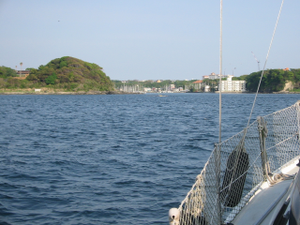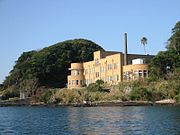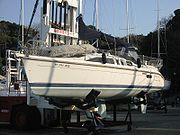- Moroiso
-
Moroiso (諸磯) is the name of an inlet in the Miura Peninsula south of Tokyo in Japan.
Contents
Prehistory
Moroiso was settled by Jōmon people by at least 3,000 BCE. Evidence from that period have been found, including sedentary to semi-sedentary housing, pottery, stone tools and fishing implements. Moroiso became the archeological name for the Early Jōmon period of Japanese prehistory corresponding to the Moroiso pottery style, dated to around 5.000 years before present. The Moroiso period also coincides with the hypsithermal interval, the warmest period since the last glaciation, when sea levels were around 6 meters higher than today.
History
During historic times, the rugged and hilly Moroiso coastline, together with the adjoining Aburatsubo inlet, was selected by the feudal Miura family to build a series of fortifications, with the Arai castle at its center. During the warring period of Sengoku, the castle fell after a 3 year siege to the rival Hōjō samurai family, in the year 1516. The Hōjō later managed to unify most of the Kantō area around Tokyo.
World War II
When the Second World War started, the Japanese Navy selected Moroiso as training school and harbour for a fleet of Kamikaze midget submarines, the Kairyu (海龍 "Sea Dragons"). They were supposed to be employed in suicide bombing missions against the US Navy during its final approach to Tokyo, but the war ended before any of them could see action.
The Imperial Japanese Navy training center for the Kairyu was located inside Moroiso, and is still visible today. It still in use today as the Oceanical Study Department of Tokyo University.
Today
Moroiso harbours a small fishing community and a few hundred pleasure boats on moorings or stored on the ground. With the neighbouring Aburatsubo inlet, Moroiso has been considered as the birthplace of modern recreational sailing in Japan.[citation needed]
Due to the lack of space on the water inside the inlet itself, many boats are stored on the ground, typically using an adapted forklift system which allows to put on the water boats up to 40ft, in a matter of minutes.
Categories:- Landforms of Japan
- Bays of Japan
Wikimedia Foundation. 2010.





